7 Easy Fruit Trees to Grow in Australia: A Beginner’s Guide to Backyard Harvests
Homegrown fruit brings fresh flavour, seasonal variety, and a strong sense of satisfaction. Whether it’s crisp apples or juicy peaches, picking produce straight from the tree turns any backyard into a productive and rewarding space.
Success begins with selecting the right tree. Some varieties are easier to grow, more productive, and better suited to Australian climates. With the right choice, even small gardens can enjoy reliable harvests for many years.
Understanding how to choose fruit trees based on climate, sunlight, space, and care needs will help create the best possible growing conditions from the start.
What to Consider When Choosing Easy Fruit Trees to Grow
Fruit trees grow best when their growing conditions match the environment around them. Paying attention to climate, space, light, and care needs helps create a garden that produces well and is easier to manage long-term.
Climate Zones in Australia
Different fruit trees thrive in different zones. Apples and cherries prefer cooler climates, while citrus trees and figs grow well in warmer or subtropical regions. Knowing your local climate zone is an essential step before selecting a tree. Local councils, nurseries, and planting guides can provide zone information for your area.
Sunlight for Fruit Production
Most backyard fruit trees need full sun to produce an abundant crop. Look for a spot that receives at least six hours of direct sunlight each day. Sunny, north-facing areas are usually the most productive in Australian gardens.
Space and Size Requirements
Backyards of all sizes can support fruit trees with the right planning. Full-size trees need more space, but dwarf and espalier varieties are ideal for courtyards, patios, or along fences. Some dwarf trees also grow well in large pots, providing flexibility for renters and small-space gardeners.
Maintenance and Care Level
Some fruit trees require seasonal pruning, pest management, or netting. Others are hardy and low-fuss, making them ideal for busy gardeners or beginners. Matching tree selection to available time and energy helps ensure a positive gardening experience.
Popular Fruit Trees
Lemon Trees
Lemon trees are among the most rewarding fruit trees for backyard gardens. They grow well in a wide range of Australian climates, produce fruit year-round, and require relatively little maintenance once established.
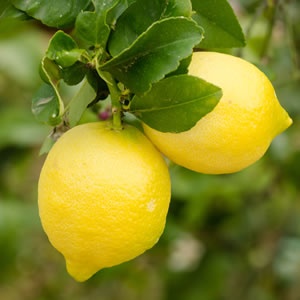
Why Lemon Trees Are a Good Choice
Lemons are hardy, evergreen, and highly productive. Popular varieties such as ‘Eureka’ and ‘Lisbon’ are ideal for backyard planting, while compact options offer sweeter fruit that suits smaller spaces and containers.
Best Time to Plant Lemon Trees
Lemon trees can be planted in spring or autumn in most parts of Australia. In colder zones, wait until the last frost has passed before planting.
Growing and Care Tips
Lemon trees grow best in full sun and well-drained soil. Regular watering helps young trees establish strong roots, but mature trees are relatively drought-tolerant. Light pruning keeps the tree healthy and encourages good fruiting. Fertilise during the growing season for best results.
Apple Trees
Apple trees are a popular choice for many Australian home gardens, especially in cooler or temperate regions. With the right variety, apple trees provide crisp, sweet fruit and beautiful spring blossoms, all with minimal upkeep.

Why Apple Trees Are a Good Choice
Apples are reliable producers and available in a range of varieties suited to different climates and garden sizes. Dwarf apple trees are perfect for small backyards or large pots, some of them are self-pollinating, which makes growing easier for beginners. Popular (self-pollinating) options include ‘Pink Lady’, ‘Granny Smith’, and ‘Gala’.
Best Time to Plant Apple Trees
Late winter to early spring is the ideal planting time for apple trees, once the coldest weather has passed.
Growing and Care Tips
Apple trees prefer full sun and rich, well-drained soil. Water regularly during dry periods and apply a balanced fertiliser in spring. Some pruning may be needed in winter to encourage shape and airflow, helping to prevent pests and diseases.
Fig Trees
Fig trees are a resilient and fast-growing option for gardeners seeking a generous yield with minimal fuss. Well-suited to warm and temperate parts of Australia, figs offer sweet, soft fruit and a striking presence in any garden.
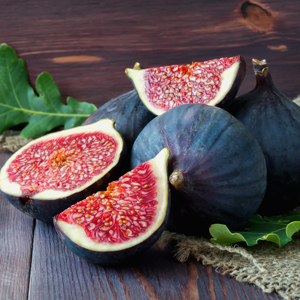
Why Fig Trees Are a Good Choice
Fig trees are known for their low maintenance requirements and ability to thrive in tough conditions. They produce abundant fruit, often twice a year, and tolerate drought once established.
Best Time to Plant Fig Trees
Plant fig trees in late winter or early spring while the tree is dormant.
Growing and Care Tips
Choose a sunny position with well-drained soil. Fig trees grow well in both open ground and containers, and they benefit from occasional pruning to manage size and improve airflow. Avoid overwatering, as figs dislike soggy roots. In most areas, birds love ripe figs, so netting may be helpful during fruiting.
Olive Trees
Olive trees are a durable and attractive choice for Australian gardens. With their silvery-green foliage and strong tolerance to heat and dry conditions, olive trees offer both visual appeal and a steady crop of homegrown olives.
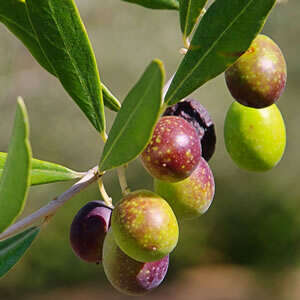
Why Olive Trees Are a Good Choice
Olives are well-suited to Australia’s Mediterranean-style climates. They are drought-tolerant, long-living, and require little care once established. Many varieties, such as ‘Manzanillo’, are self-fertile and produce reliable harvests with proper pruning and sunlight.
Best Time to Plant Olive Trees
Olive trees are best planted in early spring or autumn, avoiding periods of frost or extreme heat.
Growing and Care Tips
Plant in a sunny, open position with well-drained soil. Olive trees prefer slightly alkaline conditions and benefit from a light application of compost or slow-release fertiliser in spring. Prune lightly to maintain shape and encourage airflow. While they are low-maintenance, regular watering during dry spells will support better fruiting in young trees.
Peach and Nectarine Trees
Peach and nectarine trees bring lush foliage, spring blossoms, and juicy summer fruit to the backyard. These trees are ideal for gardeners who want reliable harvests and beautiful seasonal interest in the garden.
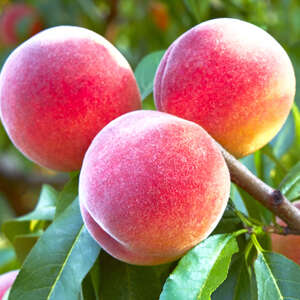
Why Peach and Nectarine Trees Are a Good Choice
Both trees are fast-growing and known for producing fruit within a few years. Dwarf varieties are perfect for small spaces and container growing. With the right variety, these trees thrive in warm and temperate climates across much of Australia.
Best Time to Plant Peach and Nectarine Trees
Late winter to early spring is the best time to plant, while trees are dormant and soil conditions are still cool and moist.
Growing and Care Tips
Choose a sunny, sheltered spot with well-drained soil. Prune annually in late summer to maintain shape and promote air circulation. Fertilise in early spring and water consistently during flowering and fruit development.
To help prevent leaf curl, spray with a copper-based or lime sulfur fungicide in late autumn after leaf fall, and again in late winter or early spring before bud swell. These treatments reduce the risk of fungal infection on new leaves.
To protect crops from pests, netting may be helpful during the ripening period.
Mulberry Trees
Mulberry trees are a favourite in Australian backyards for their rapid growth, shade-giving foliage, and generous supply of sweet, dark berries. These trees are ideal for gardeners seeking a low-effort, high-reward addition to the garden.
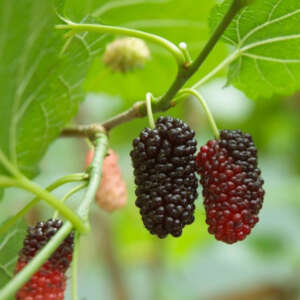
Why Mulberry Trees Are a Good Choice
Mulberries are tough, productive, and adaptable to a wide range of climates. The ‘Dwarf Black Mulberry’ is well-suited to smaller gardens and large containers, while larger varieties produce abundant crops. These trees are also popular for their fast growth and minimal maintenance.
Best Time to Plant Mulberry Trees
Plant mulberry trees in winter or early spring while they are still dormant.
Growing and Care Tips
Mulberries grow best in full sun with well-drained soil. They need regular watering during establishment, but are drought-tolerant once mature. Prune lightly after fruiting to manage size and shape. The berries are loved by birds, so fruit protection may be needed during harvest time.
Mandarin Trees
Mandarin trees are a great option for families, offering sweet, easy-to-peel fruit that children love. These trees grow well in a range of climates and are especially popular in suburban gardens for their compact size and consistent yield.
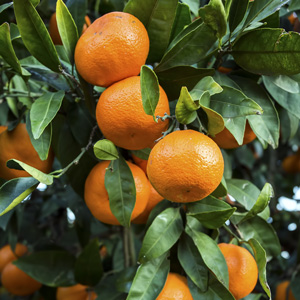
Why Mandarin Trees Are a Good Choice
Mandarins are cold-tolerant and adaptable, making them suitable for both warm and temperate regions. Dwarf varieties are ideal for smaller gardens or pots. With fragrant blossoms and glossy leaves, mandarin trees also bring visual appeal to outdoor spaces.
Best Time to Plant Mandarin Trees
The best time to plant is in early spring or autumn, avoiding the hottest and coldest parts of the year.
Growing and Care Tips
Mandarin trees prefer full sun and fertile, well-drained soil. Water consistently during dry weather and apply citrus fertiliser in spring and late summer. Prune after harvest to maintain shape and promote airflow. Young trees may benefit from light frost protection in cooler areas.
Start Growing Easy Fruit Trees at Home
Growing fruit at home is a rewarding way to enjoy fresh produce, connect with the seasons, and make the most of outdoor space. With the right selection and a few simple care routines, easy fruit trees to grow can thrive in gardens of all shapes and sizes across Australia.
Whether it is a compact mandarin for the courtyard or a productive fig tree for the back fence, the right choice can bring years of flavour and enjoyment.
Explore our full 2025 fruit trees collection to find varieties suited to your climate, space, and growing style. Ready to plant your own fruit forest? Discover the possibilities and enjoy the harvests to come.
Frequently Asked Questions About Growing Backyard Fruit Trees
What are the easiest fruit trees to grow in Australia?
Lemon, mandarin, fig, and mulberry trees are among the easiest fruit trees to grow in Australia. These varieties are low-maintenance, adaptable to different climates, and well-suited to both large backyards and small spaces.
When is the best time to plant fruit trees in Australia?
Fruit trees are best planted in late winter or early spring while they are dormant. In warmer climates, autumn is also suitable. Always avoid planting during extreme heat or frost.
Can I grow fruit trees in a small backyard or courtyard?
Yes. Many fruit trees for backyard spaces come in dwarf or compact forms. These are ideal for small gardens, courtyards, and even large pots. Dwarf apple, peach, and mandarin trees are excellent options.
Do all fruit trees need full sun?
Most fruit trees grow best in full sun, meaning six or more hours of direct sunlight each day. Sun exposure supports healthy growth, flower production, and fruit development.
How much maintenance do fruit trees need?
Care needs vary by variety, but many backyard fruit trees require minimal upkeep. Regular watering, seasonal feeding, and occasional pruning help support healthy trees and better harvests.







Comments are closed.